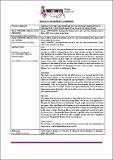Por favor, use este identificador para citar o enlazar a este item:
http://hdl.handle.net/10261/262967COMPARTIR / EXPORTAR:
 SHARE
BASE SHARE
BASE
|
|
| Visualizar otros formatos: MARC | Dublin Core | RDF | ORE | MODS | METS | DIDL | DATACITE | |

| Título: | Influence of early leaf removal on the yield and composition of the grape of three varieties in the D.O.Ca. Rioja (Spain) |
Autor: | Alti Palacios, Laura CSIC ORCID; García Vadillo, Sara CSIC; Martínez García, Juana CSIC | Palabras clave: | Early leaf removal Yield components Chemical composition White grapes |
Fecha de publicación: | 23-jun-2021 | Citación: | 8th International Macrowine Conference on Macromolecules and Secondary Metabolites of Grapevine and Wine (2021) | Resumen: | AIM: Defoliation is one of the green operations more used in viticulture, whose results can be very different depending on the variety and the moment of realization. Early leaf removal consists of the elimination of basal leaves on the shoots around pre-bloom stage, which limits fruit set and initial growth of the berry, leading to less compact clusters and less weight [1]. This practice allows to control the yield, improve the sanitary state and consequently the quality of the grape [2]. The objective of this research was to evaluate the influence of early leaf removal on the yield and composition in the grape of three white varieties: Tempranillo Blanco, Maturana Blanca and Garnacha Blanca. METHODS: This study was conducted during the 2019 season, in a vineyard located in the D.O.Ca. Rioja (Spain). At the moment of harvest, the influence of early leaf removal on different yield components (unit production, number of bunches per vine, bunch weight, weight of 100 berries and number of berries per bunch) was determined. Prior to the harvest, 500 berries were sampled for each repetition and the must was extracted. Musts were physicochemically characterized by determining probable alcohol, pH, total acidity, tartaric acid, malic acid, potassium and total polyphenols. RESULTS: The results obtained showed notable varietal differences. The early leaf removal gave rise to a decrease in the yield components, which only were significant in Tempranillo Blanco for the unit production, bunch weight and number of berries per bunch. Also, the effects of leaf removal on the composition of the grape were higher in Tempranillo Blanco. The total polyphenol content increased significantly in the three varieties. Maturana Blanca presented a significant rise in total acidity. On the contrary, Tempranillo Blanco showed a significant decrease, significantly increasing the pH and potassium. The probable alcohol showed a significant increase in Tempranillo Blanco and Garnacha Blanca. CONCLUSIONS: To conclude, the influence of early leaf removal on the yield and composition of the grape is variable depending on the variety. | Descripción: | Resumen del trabajo presentado en la 8th International Macrowine Conference on Macromolecules and Secondary Metabolites of Grapevine and Wine (Macrowine), celebrada de forma virtual en la Universidad de Verona (Italia), del 23 al 30 de junio de 2021 | URI: | http://hdl.handle.net/10261/262967 |
| Aparece en las colecciones: | (ICVV) Comunicaciones congresos |
Ficheros en este ítem:
| Fichero | Descripción | Tamaño | Formato | |
|---|---|---|---|---|
| ALTI-PALACIOS.pdf | 199,79 kB | Adobe PDF |  Visualizar/Abrir |
CORE Recommender
NOTA: Los ítems de Digital.CSIC están protegidos por copyright, con todos los derechos reservados, a menos que se indique lo contrario.
